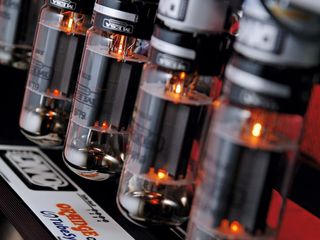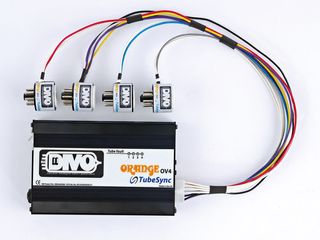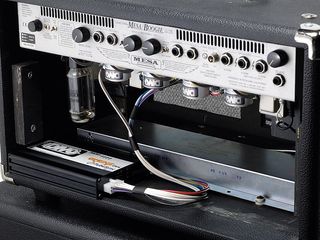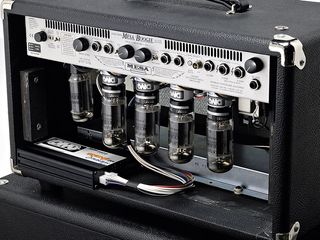What is valve bias and how does the Orange/TubeSync DIVO OV4 work?
Engine management for your guitar amp… explained!

Orange/TubeSync DIVO OV4

Orange/TubeSync DIVO OV4

Orange/TubeSync DIVO OV4

Orange/TubeSync DIVO OV4

The following information is taken from Guitarist's Orange/TubeSync DIVO OV4 review. To find out how the DIVO fared when installed in a 1970s Marshall 100-watt Super Lead head, check out the full review. If you're only interested in valve bias and how the technology works, read on…
Bias, and how to set it, is probably one of the most contentious issues for many valve amp users, especially those who like to tweak their amp by installing different makes or types of output valve.
What is bias?
Put simply, bias is your valve's idle adjustment - it's like making sure your car is ticking over properly. In fixed bias amplifiers, this is achieved by applying a negative voltage to the valve's control grid - literally a grid of wire that sits between the cathode and plate.
"Put simply, bias is your valve's idle adjustment - it's like making sure your car is ticking over properly".
When you switch your amp on, electrons are generated at the cathode and pulled towards the plate, causing current to flow. This happens because electrons are negatively charged particles and the plate is energised with a strong positive voltage - opposite poles attract.
Varying the control grid's negative voltage means this flow of electrons can be slowed to a trickle, or even stopped - like poles repel.
The ideal idle current
Although people often refer to the negative bias voltage setting, it's the actual idle current that is important. All valves have an ideal idle current, typically around 30-50 milliamps, and for the amp to operate at its best it's important that all your output valves are idling equally.
This is done by fitting valves that have been matched in pairs or quartets, however even the best matching doesn't mean that valves will wear equally, so in order to keep your amp operating at its best, an occasional small adjustment to the bias is sometimes necessary.
Get the MusicRadar Newsletter
Want all the hottest music and gear news, reviews, deals, features and more, direct to your inbox? Sign up here.
Usually these adjustments are at best a compromise; as individual output valves rarely draw the same idle current. What if there was a device that could measure and automatically adjust the bias for each individual valve? Well now there is: the Orange/TubeSync DIVO, which stands for Dynamic Intelligent Valve Optimisation.

Orange/TubeSync DIVO
It's been available in OEM format for some time, however retrofitting this to an existing amp isn't easy and is definitely beyond most guitarists' capabilities. What was needed was a simple, bolt-on accessory that can be added to any fixed bias amp, and that's what Orange has now come up with, in the shape of the DIVO OV4.
Next: how the Orange/TubeSync DIVO OV4 works

Built into an aluminium case about the size of a small paperback, the OV4 module comes with both a bracket and strong industrial Velcro fixings. Four piggyback octal sockets, or interceptors as Orange calls them, are connected to a strong nylon multi-pin plug that is located at one end of the module.
There are two small push-button switches, one offering a choice of standard and custom bias settings, while the other is called 'share the wear'. At the other end of the module there's an earth connection, together with an RJ45 socket and a standard 6mm jack socket.
The RJ45 socket is where the DIVO OV4's interface module plugs in, allowing the product to be configured and interrogated from a PC using a small Windows-compatible program. This handy software lets authorised resellers/installers configure the custom bias switch setting, either globally or for each valve individually, as well as a second 'idle only' bias current that operates as a progressive standby feature.
Micro-adjustments
Once set, the OV4 continually micro-adjusts the bias current for each individual valve, keeping the amp running at peak efficiency. It also means that you can run any combination of standard octal power valve you like, although pairs, such as 6L6s and EL34s are more useful.

With no audio present, the OV4 can automatically drop the bias current to a lower setting to reduce wear and tear, instantly returning to its higher level when audio is detected.
Valve faults?
In the event of a valve fault, a clever algorithm shuts off the affected pair automatically and remembers which valves are at fault, displaying them on warning LEDs, as well as in the software, while also keeping a record of how many hours use the amp has had, both with and without audio.
The jack socket connects to a standard footswitch letting you switch the amp from full power (all four valves on) to half power, moreover the 'share the wear' function remembers which pair of valves were switched off the last time and alternates them, keeping wear as even as possible, although if you use two different pairs of valves, such as 6L6s and EL34s, you can use this as a tone option, swapping from one pair to the other. Cool or what?
Skip to page two of Guitarist's Orange/TubeSync DIVO OV4 review to find out how the kit fared when installed in a 1970s Marshall 100-watt Super Lead head.
Most Popular


